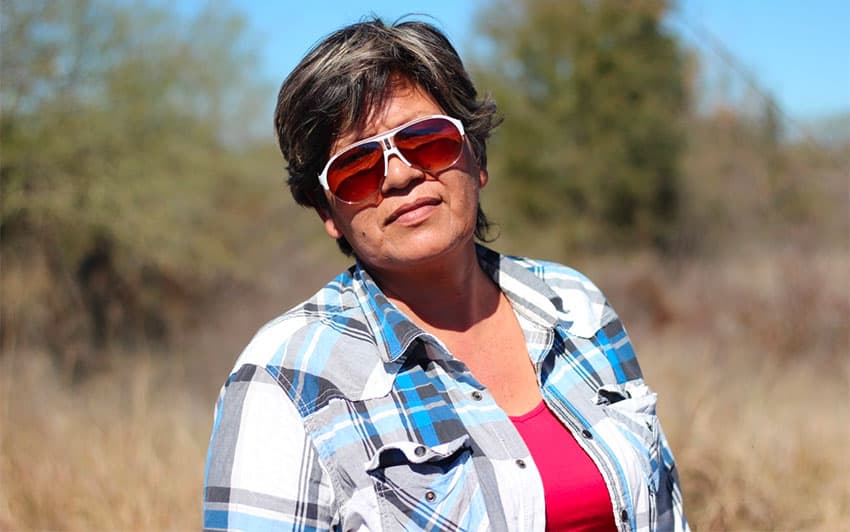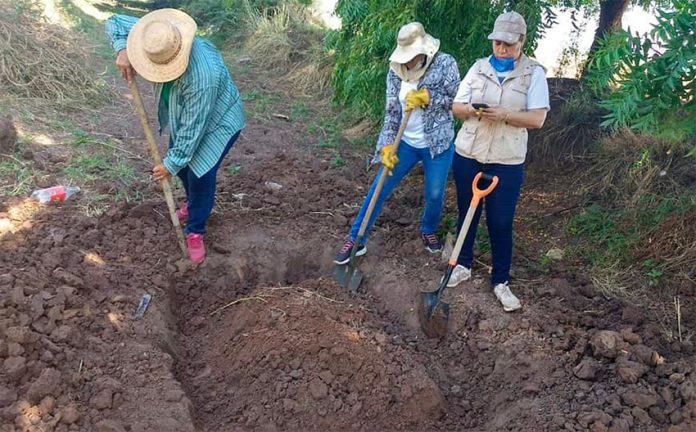Verónica López Álvarez sinks a long, T-shaped rod into the soft earth, pulls it out, smells it and screws up her face. Six other women flock around to sniff too, reeling back in horror at a stench like rotting fish.
Then it’s action stations. “We’re going to dig here,” says Delfina Herrera Ruíz. “It’s a body.”
With their shovels, the women — mostly housewives in their 40s and 50s, some manicured and made-up in the sticky morning sun — start sifting the earth with shallow, careful movements. The banter en route to El Teroque Viejo, in Sinaloa in northwest Mexico has given way to a grim focus.
Mirna Medina Quiñonez, the group’s leader, hits a bone with her spade. Among butterflies fluttering in the breeze and birds singing, these mothers and sisters are hunting for their dead — what Medina calls their missing “treasures.” Their group is known as the Rastreadoras del Fuerte (the searchers of El Fuerte) — a reference to the place where Medina’s son disappeared.
Their “treasures” are among the more than 82,000 people recorded as having disappeared and not been located in Mexico since 2006, when the government declared a war on drug cartels, unleashing terrible, seemingly unstoppable violence. Notwithstanding Covid-19, 2020 may prove to have been the deadliest year on record. As of November there had been 31,871 murders, compared with a record 34,648 in 2019.

These women have been rescuing their loved ones’ memories in more ways than one. Together, they have created Recipes to Remember, a book of favourite dishes of some of the missing. Each dish has the name of the person it was made for and the date they disappeared. It was the idea of Zahara Gómez Lucini, a Spanish-Argentine photographer who has documented the group since 2016.
The book has only recently been published and when I show it to Herrera, it is the first time she has seen it. It gives her goosebumps just to hold it, she says. Turning to the recipe for shrimp ceviche that she contributed in memory of her youngest brother, Luis Reinaldo Herrera Ruíz, she smiles. Then sorrow clouds her face: Luis Reinaldo disappeared in 2016, aged 51. With her baseball cap bearing the message “Where are you, you old bastard?” she has been looking for him ever since.
The women’s shovels have unearthed some shredded orange plastic, sometimes used to tie victims up. At the sight of the bone, the mood becomes tense. Medina expertly teases it free. A heady stench hangs in the air. More bones emerge.
But it is a false alarm. These are the ribs of an animal — they are too big, and the smell is not that of a decomposing human body, she says. “Still, we have to rule everything out.” The women fill in their hole, pack up their shovels, and set off to search somewhere else.
According to official data, Mexico has counted 4,092 clandestine graves and exhumed 6,900 bodies since 2006. Sinaloa is notorious as the home of Joaquín “El Chapo” Guzmán, once Mexico’s most powerful drug baron, now locked up in a maximum-security jail in the U.S. The city of Los Mochis, where the Rastreadoras are based, is currently in the grip of Fausto Isidro Meza Flores, known as El Chapo Isidro.
The Rastreadoras give short shrift to the idea that they could turn to the authorities for help, rather than searching for victims themselves. As shown in the mass disappearance of 43 Mexican students in 2014, which rocked the country, municipal police have a terrible reputation for being infiltrated by cartels. “They won’t help us — they’re the same ones who are involved,” scoffs Reyna Rodríguez Peñuelas, whose son, Eduardo González Rodríguez, disappeared in 2016.

Since taking office in 2018, the government of President López Obrador has stepped up efforts to locate missing people and identify bodies. It says the number of reported disappearances for 2020 was trending down. But the government acknowledged in November that in 2019, a record 8,804 people had been reported missing and not been found.
Worse, says Karla Quintana, head of the National Search Commission, a government agency spearheading efforts to find Mexico’s missing, “there have only been 25 sentences passed for forced disappearances in Mexico … and we’re still missing more than 82,000 people.”
Many, like Rosa Elvira Cervantes Meza, whose son Víctor Ulíses Acosta Cervantes has been missing for “four years, two months,” count the time with the precision of a new mother measuring her baby’s age to the week.
Ofelia Flores Moreno succeeded in finding the body of her husband, José Candelario Espinoza Ochoa, a month after he disappeared in 2017, but not thanks to the police. “They say they’ll investigate, but do nothing. If I went there now, they’d say the same thing,” she says, speaking in the Rastreadoras’ offices where the walls are plastered with missing-person notices.
The women have gathered to be presented with copies of the book. Jessica Higuera Torres speaks of her son Jesús Javier López Higuera, who disappeared in 2018, in the present tense. For the book, she prepared a soup with pork rind because “he loves it — when I was cooking, I felt as though he was by my side.”
On the other hand, Esther Preciado no longer cooks chile ribs, her recipe for her daughter’s father, Vladimir Castro Flores, who has been missing since 2013. “That one’s just for the memories now,” she says.

A former nursery-school teacher, Rastreadoras founder Medina, 50, talks fast, fuelled by “about 20 cups of coffee a day.” She founded the organization after her son, Roberto Corrales Medina, disappeared in 2014, leaving three daughters and another child on the way. “I kept looking for Roberto because they left him somewhere,” she says simply. Three years to the day after he went missing, she located bone fragments that proved to be his. Having found him, she sports a green shirt with “Promise Kept” on the back. Those still hunting wear white ones that read: “I’ll look for you until I find you.”
“You get addicted to searching,” she says. The 120 or so Rastreadoras have found 68 people, but only about a quarter of those are their missing loved ones. She acknowledges many victims may have got into trouble because they sold or used drugs; others were just in the wrong place at the wrong time.
Despite being the driving force behind the Rastreadoras, Medina says she almost didn’t meet the deadline for the book. Her recipe for pizadillas, meat and cheese-filled tortillas, was the last to be included and, she says: “I’m terrible at cooking.” Yet preparing it, she felt her son’s eyes on her “and that relieved some of the pain.”
For the Rastreadoras, food strengthens community — and, as Gómez says, “the book is a tool for building ties.” After coming back empty-handed from today’s search, the women pull out a table and share a meal.
“This recipe book is very important because it’s an exercise in collective memory and that’s very necessary,” says Enrique Olvera, the chef and restaurateur behind Pujol in Mexico City and Cosme in New York and a sponsor of the book. “It enables the Rastreadoras to connect with the memory of their loved ones through food and brings us, the readers, closer … It weaves empathy.” Olvera donated proceeds from dinners organized with two other Mexican chefs, Lalo García and Óscar Herrera, to help fund the book’s publication. Half of its proceeds go to the Rastreadoras.
Demonstrating her friend Susy Atondo Gastélum’s favourite dish, Erika Acosta González de-veins shrimps, chops cucumbers and squeezes lemons. She sprinkles the seafood with coarse salt — “Susy said it doesn’t pickle properly otherwise” — and follows her friend’s preference for red, not white, onion, plus green serrano chiles.
“I said when she comes back to see me, this is the first thing I’ll make her,” she smiles, although it has been more than seven years. “I dreamed she’d died and I’d find her. I dreamed of her eight days in a row. But she’s never told me where she is.”
Jude Webber is The Financial Times‘ Mexico and Central America correspondent.
© 2021 The Financial Times Ltd. All rights reserved. Please do not copy and paste FT articles and redistribute by email or post to the web.
